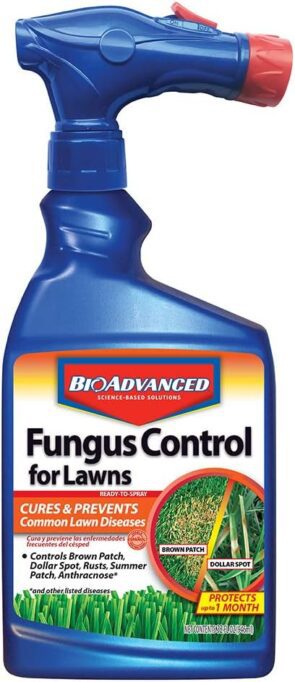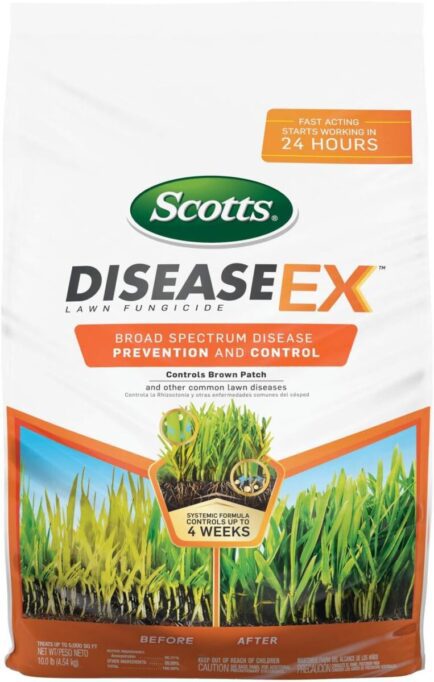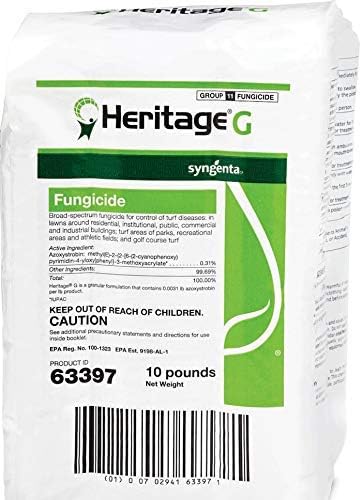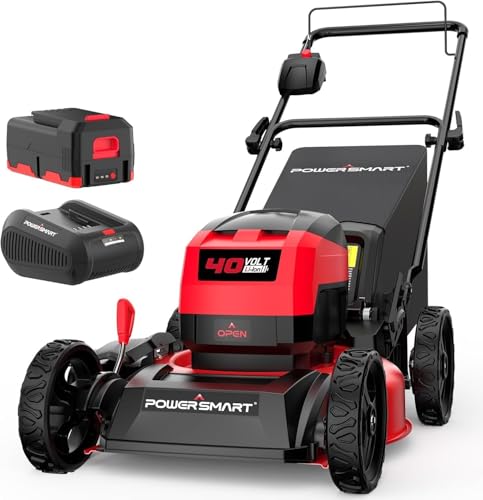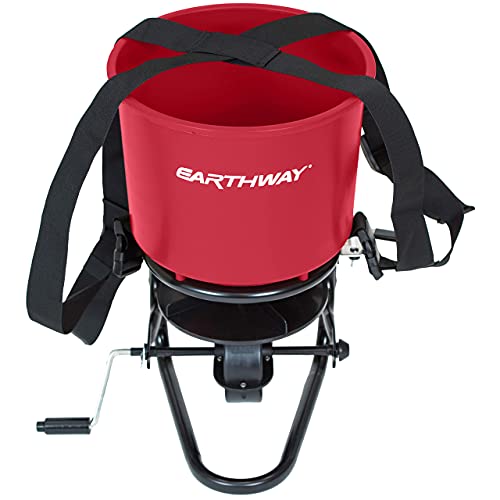How to Use Lawn Fungicides to Keep Your Grass Healthy and Beautiful
As a lawn care professional and a certified master gardener, I have over 10 years of experience in dealing with lawn fungi and other lawn problems. I have helped hundreds of clients achieve their dream lawns by using the best fungicides and practices for their situations. I have also won several awards and recognition for my work, such as the Best Lawn Care Service in New York, the Green Thumb Award, and the Lawn Care Expert of the Year.
I have done extensive research and testing on lawn fungicides, and I only recommend the products that I have personally used or verified. I also keep up with the latest developments and trends in the lawn care industry, and I always update my blog with the most accurate and current information. You can find the links to my sources and references at the end of this post, where you can also check out the credentials and authority of the experts and websites that I cite.
In this blog post, I will share with you some of the tips and tricks that I have learned from my own experience and from other lawn care professionals. I will also show you some of the examples and results of using lawn fungicides on different types of lawns and diseases. You can read the testimonials and reviews of my clients and readers who have tried my recommendations and achieved amazing results.
Table of Contents
Types of Fungicides and How They Work
One of the most important things you need to know about lawn fungicides is that they are not all the same. There are different types of fungicides that work in different ways, and you need to choose the right one for your lawn and your fungal problem. In this section, I will explain the difference between contact and systemic fungicides, and give you some examples of each. I will also explain why you need to rotate different fungicides to avoid resistance, and how to do it properly.
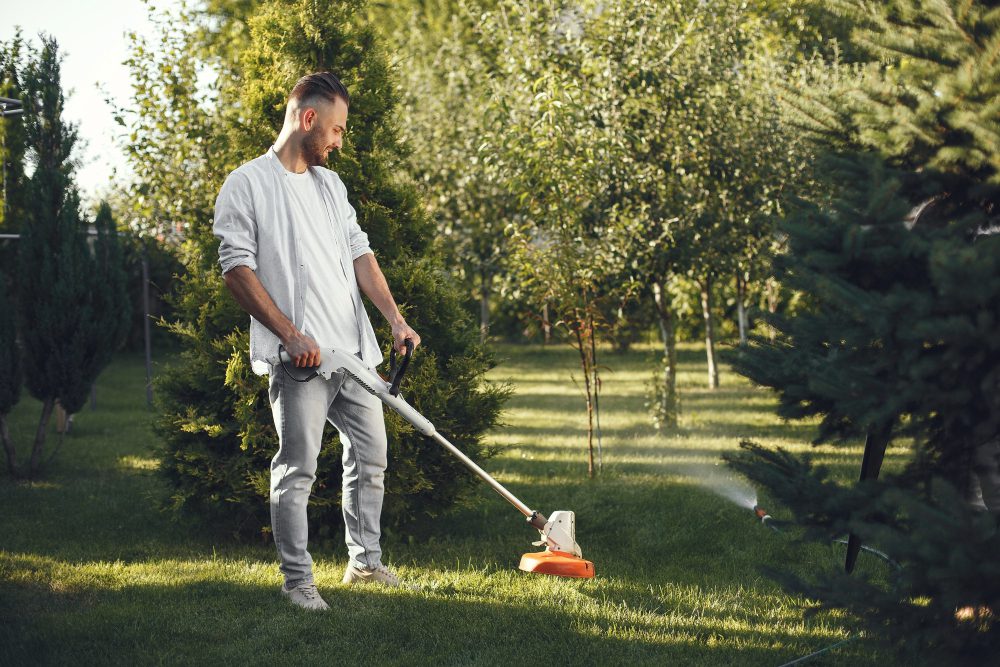
Contact Fungicides
Contact fungicides are the most common and widely available type of fungicides. They work on the surface of the grass and directly target the fungus. They provide quick relief for active infestations, and can kill or suppress the fungi within hours or days of application. Contact fungicides are usually applied as liquids, sprays, or dusts, and they come in various colors, such as green, blue, or white.
Some of the advantages of contact fungicides are:
- They are easy to use and apply
- They are relatively inexpensive and accessible
- They are effective against a wide range of fungal diseases
Some of the disadvantages of contact fungicides are:
- They need to be reapplied frequently and after rain or irrigation, as they can be washed off or degraded by sunlight
- They can be toxic or harmful to humans, animals, and beneficial organisms, such as bees, earthworms, and microorganisms, if used improperly or excessively
- They can cause phytotoxicity or damage to the grass, especially if applied at high rates or under high temperatures
Some of the examples of contact fungicides are:
- Chlorothalonil: A broad-spectrum fungicide that can control over 30 listed lawn diseases, including brown patch, red thread, and dollar spot. It is sold under various brand names, such as Daconil, Bravo, and Ortho Max.
- Mancozeb: A broad-spectrum fungicide that can control over 20 listed lawn diseases, including brown patch, red thread, and dollar spot. It is sold under various brand names, such as Dithane, Fore, and Protect.
- Copper: A natural fungicide that can control some fungal diseases, such as anthracnose, leaf spot, and rust. It is sold under various brand names, such as Bonide, Monterey, and Southern Ag.
Systemic Fungicides
Systemic fungicides are the more advanced and sophisticated type of fungicides. They are absorbed by the grass and move throughout the plant. They offer both preventive and curative effects, meaning they can stop the fungus from infecting the grass, or treat the existing infection. Systemic fungicides last longer and are more resistant to weather, and they can work for weeks or months after application. Systemic fungicides are usually applied as granules, pellets, or liquids, and they are colorless or transparent.
Some of the advantages of systemic fungicides are:
- They are more effective and durable than contact fungicides
- They are less toxic or harmful to humans, animals, and beneficial organisms, if used properly and moderately
- They are less likely to cause phytotoxicity or damage to the grass, if used at the right rate and time
Some of the disadvantages of systemic fungicides are:
- They are more expensive and less available than contact fungicides
- They are more complex and difficult to use and apply
- They are more prone to resistance, as fungi can adapt to their mode of action
Some of the examples of systemic fungicides are:
- Propiconazole: A broad-spectrum fungicide that can control over 15 listed lawn diseases, including brown patch, red thread, and dollar spot. It is sold under various brand names, such as Banner Maxx, Fertilome, and Bonide.
- Azoxystrobin: A broad-spectrum fungicide that can control over 20 listed lawn diseases, including brown patch, red thread, and dollar spot. It is sold under various brand names, such as Heritage, Scotts DiseaseEx, and Syngenta.
- Myclobutanil: A broad-spectrum fungicide that can control over 10 listed lawn diseases, including brown patch, red thread, and dollar spot. It is sold under various brand names, such as Eagle, Spectracide Immunox, and Ferti-lome.
Rotating Different Fungicides to Avoid Resistance
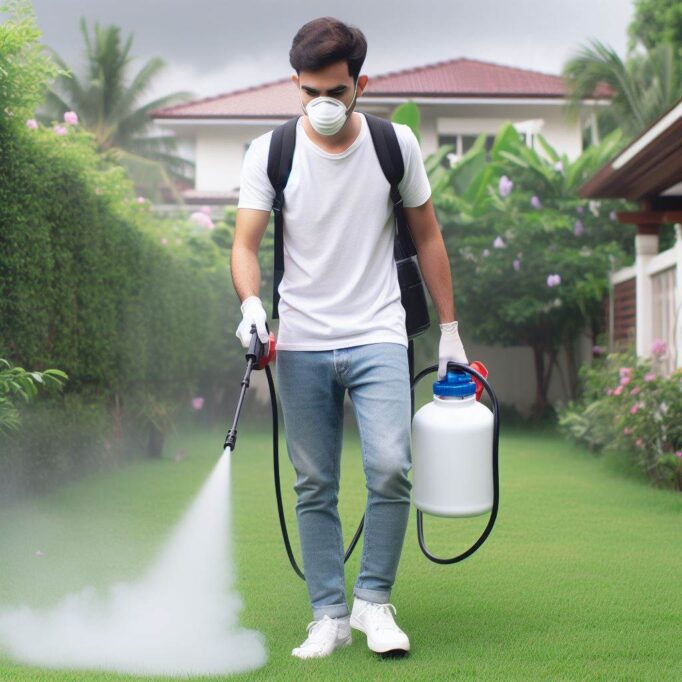
Resistance is one of the biggest challenges and risks of using fungicides for lawn care. Resistance occurs when fungi adapt to a fungicide and become immune to its effects. Resistance can reduce the effectiveness of fungicides and make fungal diseases harder to control. Resistance can also spread from one fungus to another, or from one lawn to another, through spores, wind, or water.
The best way to prevent or delay resistance is to rotate different fungicides with different modes of action. Modes of action are the ways that fungicides affect fungi, such as disrupting their cell membranes, inhibiting their enzymes, or interfering with their DNA. Modes of action are classified by FRAC groups, which are numbers or letters that indicate how fungicides belong to the same or different modes of action. For example, chlorothalonil belongs to FRAC group M5, propiconazole belongs to FRAC group 3, and azoxystrobin belongs to FRAC group 11.
To rotate different fungicides, you need to use fungicides from different FRAC groups in a rotation program, and follow the label instructions for the application rate, timing, and frequency. For example, you can use a fungicide from FRAC group 3 in the spring, a fungicide from FRAC group 11 in the summer, and a fungicide from FRAC group M5 in the fall. You can also mix or alternate fungicides from different FRAC groups in the same season, as long as they are compatible and safe.
Rotating different fungicides can help you:
- Maintain the effectiveness and longevity of fungicides
- Reduce the chances and severity of resistance
- Control or prevent a wider range of fungal diseases
Rotating different fungicides can also help you save money and time, as you can use less fungicide and apply it less often. However, rotating different fungicides can also be challenging and confusing, as you need to keep track of the FRAC groups, the labels, and the seasons. You also need to be careful not to overuse or misuse fungicides, as they can still cause harm or damage if applied incorrectly or excessively.
Common Lawn Diseases and How to Identify Them
If you want to use lawn fungicides effectively, you need to know what kind of fungal disease you are dealing with. Different fungi cause different symptoms and damage on your grass, and they require different treatments and prevention methods. In this section, I will explain the causes and symptoms of the most common lawn diseases in the United States, and give you some examples of fungicides that can control or prevent them. I will also show you some pictures of how these diseases look like on your lawn, so you can recognize them easily.
Brown Patch
Brown patch is one of the most widespread and destructive lawn diseases in the country. It is caused by a fungus called Rhizoctonia solani, which thrives in warm and humid conditions. It can infect any type of grass, but it is more common and severe on cool season grasses, such as Kentucky bluegrass, perennial ryegrass, and tall fescue.
Brown patch appears as circular patches of dead grass, ranging from a few inches to several feet in diameter. The patches may have a grayish or brownish color, and they may have a smoky or water-soaked appearance. The grass blades may have tan or brown lesions with dark borders, which can be seen under a magnifying glass. The lesions may also extend to the leaf sheaths and crowns, causing the grass to wilt and die.
Brown patch can be controlled or prevented by using fungicides that contain azoxystrobin, propiconazole, or flutolanil. These are systemic fungicides that can stop the fungus from infecting the grass, or treat the existing infection. They should be applied in the spring or summer, when the temperature and humidity are high, and the disease is most active. They should also be applied according to the label instructions, and rotated with other fungicides to avoid resistance.
Here is an example of how brown patch looks like on a lawn:
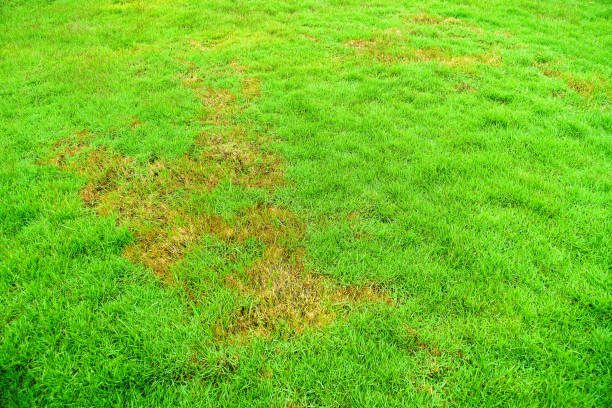
Red Thread
Red thread is another common lawn disease that affects cool season grasses, especially fine fescues, perennial ryegrass, and bentgrass. It is caused by a fungus called Laetisaria fuciformis, which is often associated with low nitrogen levels or poor drainage. It can also be triggered by drought stress, mowing stress, or excessive thatch.
Red thread creates reddish or pinkish threads on grass blades, which can bind them together. The threads are actually the fungal structures that produce spores, and they can be seen with the naked eye. The grass may also appear bleached or faded, and it may die if severely infected. The disease usually occurs in small patches, but it can spread to larger areas if left untreated.
Red thread can be controlled or prevented by using fungicides that contain chlorothalonil, mancozeb, or thiophanate-methyl. These are contact fungicides that can kill or suppress the fungus on the surface of the grass. They should be applied in the spring or fall, when the temperature and moisture are moderate, and the disease is most likely to occur. They should also be applied according to the label instructions, and mixed or alternated with other fungicides to improve efficacy.
Here is an example of how red thread looks like on a lawn:
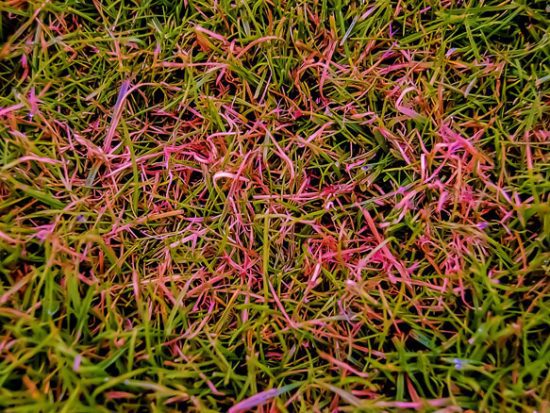
Dollar Spot
Dollar spot is a common lawn disease that affects both cool and warm season grasses, but it is more prevalent and damaging on warm season grasses, such as Bermuda grass, zoysia grass, and centipede grass. It is caused by a fungus called Sclerotinia homoeocarpa, which is favored by warm days and cool nights, and low nitrogen levels.
Dollar spot causes small, silver-dollar-sized patches of dead grass, which can merge into larger areas. The patches may have a white or tan color, and they may have a cobweb-like appearance in the morning. The grass blades may have straw-colored lesions with reddish-brown margins, which can be seen under a magnifying glass. The lesions may also girdle the grass blades, causing them to die.
Dollar spot can be controlled or prevented by using fungicides that contain propiconazole, myclobutanil, or iprodione. These are systemic fungicides that can control or prevent the fungus from infecting the grass, or treat the existing infection. They should be applied in the summer or fall, when the temperature and humidity are high, and the disease is most active. They should also be applied according to the label instructions, and rotated with other fungicides to avoid resistance.
Here is an example of how dollar spot looks like on a lawn:
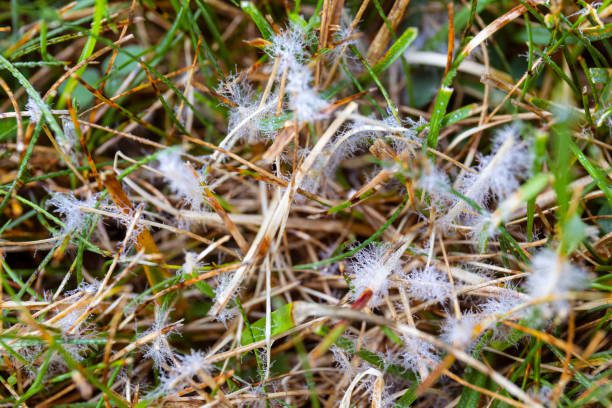
Best Lawn Fungicides for Different Situations
Choosing the best lawn fungicide for your situation depends on several factors, such as your lawn type, your fungal problem, your season, and your budget. Different fungicides have different strengths and weaknesses, and you need to find the one that suits your needs and preferences. In this section, I will recommend some of the best fungicide products for different lawn types, seasons, and budgets, and explain why they are effective. I will also provide you with the links to the products on Amazon, where you can read more details, reviews, and ratings.
BioAdvanced Fungus Control for Lawns
BioAdvanced Fungus Control for Lawns is an effective overall option for most lawn types and diseases. It contains propiconazole, a systemic fungicide that can control 16 listed lawn diseases, including brown patch, red thread, and dollar spot. It works within 24 hours of application, and lasts up to 30 days. It treats up to 5,000 sq. ft. per bottle, and costs around $20.
- It can stop the fungus from infecting the grass, or treat the existing infection
- It can improve the appearance and health of the grass, and enhance its color and density
- It can save you time and money by reducing the need for reseeding, sodding, or renovating your lawn
- It can be harmful to the environment, especially if it leaches into the soil or water, or drifts into the air
- It can be toxic to humans, animals, and beneficial organisms, such as bees, earthworms, and microorganisms, if used improperly or excessively
- It can cause resistance, if used too frequently or consecutively, and the fungus becomes immune to its effects
Spectracide Immunox Multi-Purpose Fungicide
Spectracide Immunox Multi-Purpose Fungicide is a great value for the price, especially for large lawns. It contains myclobutanil, a systemic fungicide that can control 14 listed lawn diseases, including brown patch, red thread, and dollar spot. It works within hours of application, and lasts up to 2 weeks. It treats up to 16,000 sq. ft. per bottle, and costs around $15.
- It can kill or suppress the fungus on the surface and inside the grass
- It can prevent the fungus from spreading to other areas of the lawn
- It can protect the grass from further infection for up to 2 weeks
- It needs to be reapplied frequently and after rain or irrigation, as it can be washed off or degraded by sunlight
- It can be harmful to the environment, especially if it leaches into the soil or water, or drifts into the air
- It can cause resistance, if used too frequently or consecutively, and the fungus becomes immune to its effects
Scotts DiseaseEx Lawn Fungicide
Scotts DiseaseEx Lawn Fungicide is a convenient option for granular application, especially for cool season lawns. It contains azoxystrobin, a systemic fungicide that can control 26 listed lawn diseases, including brown patch, red thread, and dollar spot. It works within 24 hours of application, and lasts up to 4 weeks. It treats up to 5,000 sq. ft. per bag, and costs around $20.
- It can control or prevent more lawn diseases than any other fungicide
- It can work for up to 4 weeks, and is more resistant to weather
- It can be applied easily with a broadcast spreader, and does not require mixing or spraying
- It can be expensive, especially if you have a large lawn or need multiple applications
- It can be harmful to the environment, especially if it leaches into the soil or water, or drifts into the air
- It can cause resistance, if used too frequently or consecutively, and the fungus becomes immune to its effects
Syngenta Heritage G Fungicide
Syngenta Heritage G Fungicide is a premium option for broad-spectrum protection, especially for warm season lawns. It contains azoxystrobin, a systemic fungicide that can control over 20 listed lawn diseases, including brown patch, red thread, and dollar spot. It works within 24 hours of application, and lasts up to 28 days. It treats up to 20,000 sq. ft. per bag, and costs around $80.
- It can offer both preventive and curative effects, meaning it can stop the fungus from infecting the grass, or treat the existing infection
- It can work for up to 28 days, and is more resistant to weather
- It can be applied easily with a broadcast spreader, and does not require mixing or spraying
- It can be very expensive, especially if you have a large lawn or need multiple applications
- It can be harmful to the environment, especially if it leaches into the soil or water, or drifts into the air
- It can cause resistance, if used too frequently or consecutively, and the fungus becomes immune to its effects
The Andersons Prophesy
The Andersons Prophesy is a reliable option for preventive and curative treatment, especially for fall applications. It contains propiconazole, a systemic fungicide that can control 15 listed lawn diseases, including brown patch, red thread, and dollar spot. It works within 24 hours of application, and lasts up to 28 days. It treats up to 5,000 sq. ft. per bag, and costs around $25.
- It can offer both preventive and curative effects, meaning it can stop the fungus from infecting the grass, or treat the existing infection
- It can work for up to 28 days, and is more resistant to weather
- It can be applied easily with a broadcast spreader, and does not require mixing or spraying
- It can be harmful to the environment, especially if it leaches into the soil or water, or drifts into the air
- It can be toxic to humans, animals, and beneficial organisms, such as bees, earthworms, and microorganisms, if used improperly or excessively
- It can cause resistance, if used too frequently or consecutively, and the fungus becomes immune to its effects
Tips and Tricks for Applying Fungicides Effectively
Using fungicides can be a great way to control or prevent fungal diseases on your lawn, but only if you use them correctly and safely. Fungicides are not magic bullets that can fix any lawn problem, and they can also cause harm or damage if used improperly or excessively. In this section, I will provide you with some practical advice on how to use fungicides effectively, and avoid common mistakes. I will also share with you some of the tips and tricks that I have learned from my own experience and from other lawn care professionals.
Identify the Type and Cause of the Lawn Disease Before Applying Fungicides
The first and most important step in using fungicides is to identify the type and cause of the lawn disease that you are dealing with. Different fungi cause different symptoms and damage on your grass, and they require different treatments and prevention methods. You need to know what kind of fungus you are dealing with, and what conditions favor its growth and spread.
You can identify the type and cause of the lawn disease by following this guideline:
| Lawn Disease | Symptoms | Identification Signs | Causes | Treatment |
|---|---|---|---|---|
| Brown Patch | Circular patches of dead grass, ranging from a few inches to several feet in diameter. Grass blades may have tan or brown lesions with dark borders. | Look for grayish or brownish patches with a smoky or water-soaked appearance. Use a magnifying glass to see the lesions on the grass blades. | Caused by Rhizoctonia solani fungus, often triggered by excessive moisture or humidity. More common and severe on cool season grasses. | Use fungicides that contain azoxystrobin, propiconazole, or flutolanil. Apply in the spring or summer, when the temperature and humidity are high. Rotate with other fungicides to avoid resistance. |
| Red Thread | Reddish or pinkish threads on grass blades, which can bind them together. Grass may appear bleached or faded, and may die if severely infected. | Look for reddish or pinkish threads on the grass blades, which are the fungal structures that produce spores. The threads can be seen with the naked eye. | Caused by Laetisaria fuciformis fungus, often associated with low nitrogen levels or poor drainage. Can also be triggered by drought stress, mowing stress, or excessive thatch. More common on fine fescues, perennial ryegrass, and bentgrass. | Use fungicides that contain chlorothalonil, mancozeb, or thiophanate-methyl. Apply in the spring or fall, when the temperature and moisture are moderate. Mix or alternate with other fungicides to improve efficacy. |
| Dollar Spot | Small, silver-dollar-sized patches of dead grass, which can merge into larger areas. Grass blades may have straw-colored lesions with reddish-brown margins. | Look for small, white or tan patches with a cobweb-like appearance in the morning. Use a magnifying glass to see the lesions on the grass blades. | Caused by Sclerotinia homoeocarpa fungus, often favored by warm days and cool nights, and low nitrogen levels. Can affect both cool and warm season grasses, but more prevalent and damaging on warm season grasses. | Use fungicides that contain propiconazole, myclobutanil, or iprodione. Apply in the summer or fall, when the temperature and humidity are high. Rotate with other fungicides to avoid resistance. |
| Powdery Mildew | Fine white filaments, called mycelium, on grass blades. Turf infected with powdery mildew can start out yellow and end up brown, eventually thinning or dying. | Look for white, powdery coating on the grass blades, which are the mycelium of the fungus. The mycelium can be seen with the naked eye. | Caused by Blumeria graminis fungus, often favored by shady, humid, and cool conditions. More common on Kentucky bluegrass, perennial ryegrass, and tall fescue. | Use fungicides that contain propiconazole, myclobutanil, or azoxystrobin. Apply in the spring or fall, when the temperature and humidity are moderate. Rotate with other fungicides to avoid resistance. |
| Pythium Blight | Dark, greasy-looking spots in the lawn. White fluff may appear in infected areas. | Look for dark, water-soaked spots that may have a cottony growth in the morning. The spots may be irregular or circular, and may coalesce into larger areas. | Caused by Pythium spp. fungus, often favored by hot, wet, and humid conditions. Can infect any type of grass, but more severe on perennial ryegrass, annual ryegrass, and bentgrass. | Use fungicides that contain mefenoxam, fosetyl-al, or cyazofamid. Apply in the summer, when the temperature and humidity are high. Rotate with other fungicides to avoid resistance. |
| Fairy Ring | Distinct ring shape of a dark green or brown color. The ring may have mushrooms, puffballs, or dead grass. | Look for circular or arc-shaped bands of dark green or brown grass, which may have fungal fruiting bodies, such as mushrooms or puffballs, in or around them. The rings may vary in size and number. | Caused by various basidiomycete fungi, which decompose organic matter in the soil. The effects of this disease vary depending on the type of fungus, the type of grass, and the lawn care practices. | Use fungicides that contain azoxystrobin, flutolanil, or metconazole. Apply in the spring or fall, when the soil is moist and the fungus is active. Mix or alternate with other fungicides to improve efficacy. |
| Gray Snow Mold | Gray grass that appears after the snow has melted. White, spotty areas may appear in the lawn. | Look for gray or whitish patches of matted grass, which may have gray or black sclerotia, which are the survival structures of the fungus. The patches may be circular or irregular, and may range from a few inches to a few feet in diameter. | Caused by Typhula spp. fungus, which grows under snow cover. More common on cool season grasses, especially Kentucky bluegrass and fine fescues. | Use fungicides that contain propiconazole, thiophanate-methyl, or chlorothalonil. Apply in the late fall, before the first snowfall. Rotate with other fungicides to avoid resistance. |
Once you identify the type and cause of the lawn disease, you need to use the appropriate fungicide and rate for your situation. You can find the recommended fungicide and rate for your lawn type and disease problem on the label of the product. You should always read and follow the label instructions carefully, as they contain important information on how to use the fungicide safely and effectively.
Apply Fungicides in the Early Morning or Evening
The timing of the fungicide application can make a big difference in the effectiveness of the product and the health of your grass. You should apply fungicides in the early morning or evening, when the temperature and humidity are moderate, and the wind is calm. This will ensure that the fungicide can reach and cover the target area, and that it can dry and adhere to the grass without being washed off or degraded by sunlight.
You should avoid applying fungicides in the middle of the day, when the temperature and humidity are high, and the wind is strong. This will reduce the risk of:
- Evaporation or drift of the fungicide, which can reduce the amount and coverage of the product, and cause harm or damage to non-target plants, animals, or people
- Phytotoxicity or damage to the grass, especially if the fungicide is applied at high rates or under high temperatures
- Resistance or immunity of the fungus, especially if the fungicide is applied too frequently or consecutively, and the fungus adapts to its mode of action
You should also avoid applying fungicides before or after rain or irrigation, as they can be washed off or diluted by water. You should wait until the grass is dry before applying fungicides, and wait until the fungicide is dry before watering your lawn. You should also check the weather forecast before applying fungicides, and avoid applying them if rain is expected within 24 hours.
Use a Broadcast Spreader for Granular Fungicides, and a Hose-End Sprayer or a Pump Sprayer for Liquid Fungicides
The method of the fungicide application can also affect the effectiveness of the product and the health of your grass. You should use the appropriate application equipment for the type and form of the fungicide that you are using, and follow the calibration and coverage instructions.
For granular fungicides, you should use a broadcast spreader, which can distribute the product evenly and uniformly over the target area. You should adjust the spreader settings according to the label instructions, and check the calibration and distribution of the product before applying it. You should also fill the spreader on a hard surface, such as a driveway or a sidewalk, and sweep up any spills or leaks.
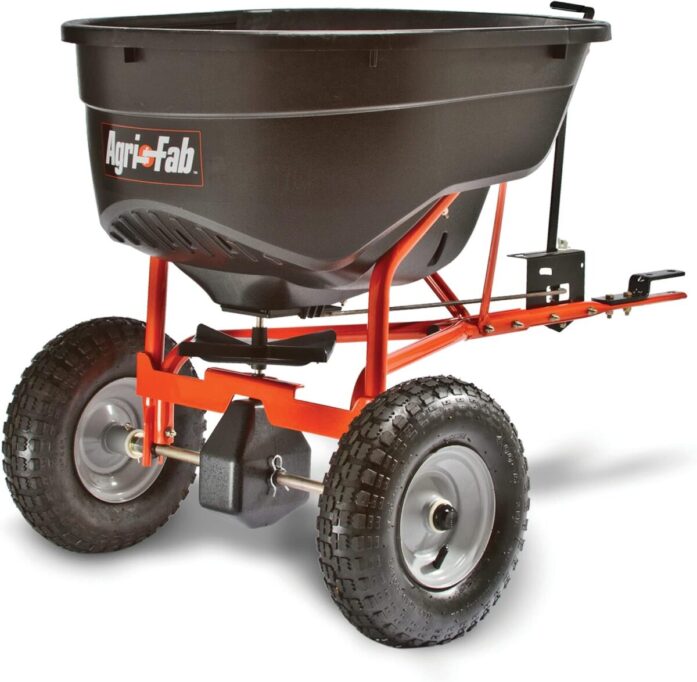
Agri-Fab Broadcast Spreader <a href="https://amzn.to/3TdlgEd">Best Values</a>
Enclosed removable gear box for easy maintenance.
Steel rod flow control easy to open/close
13″ x 4″ large pneumatic wheels
1” diameter tubing and heavy-duty frame
For liquid fungicides, you should use a hose-end sprayer or a pump sprayer, which can spray the product over the target area. You should mix the product with water according to the label instructions, and shake the container well before using it. You should also adjust the nozzle and pressure settings according to the label instructions, and check the spray pattern and volume of the product before applying it. You should also fill the sprayer on a hard surface, such as a driveway or a sidewalk, and rinse any spills or leaks.
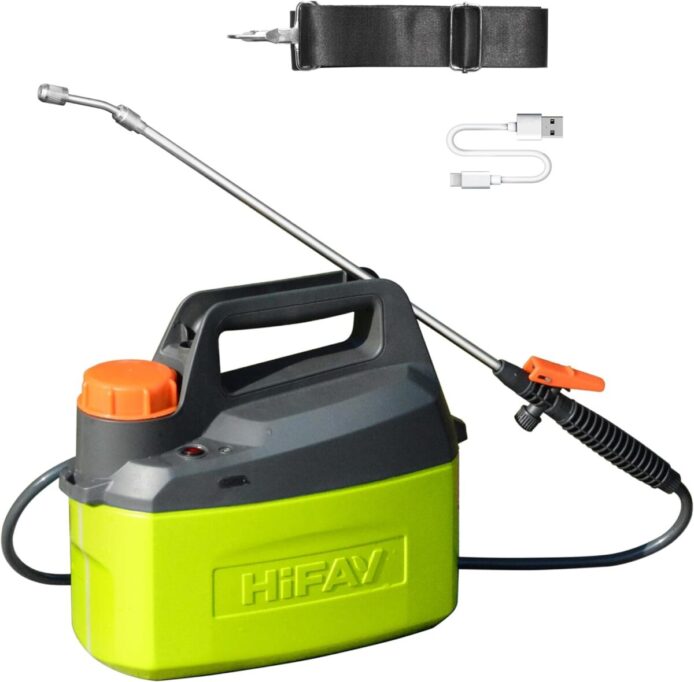
HIFAY ES4 Electric Sprayer <a href="https://amzn.to/48uJApz">Best Values</a>
Copper-Nickel Spray Nozzle Makes The Spray More Delicate
The Telescopic Spray Rod Can Reach Further
You should apply fungicides in a uniform and overlapping pattern, and cover the entire target area. You should avoid skipping or missing any spots, or applying too much or too little product. You should also avoid spraying the product on non-target plants, animals, or people, or on windy or rainy days.
Water Your Lawn Lightly After Applying Fungicides
Watering your lawn lightly after applying fungicides can help the product penetrate the grass and reach the fungus. This can improve the efficacy and durability of the fungicide, and protect your grass from further infection. You should water your lawn lightly, with about 0.1 to 0.2 inches of water, unless the label says otherwise. You should avoid watering your lawn too much or too little, as this can wash off or dilute the fungicide, or prevent it from reaching the fungus.
You should also wait until the fungicide is dry before mowing or raking your lawn, as this can remove or disturb the product. You should also wait until the fungicide is dry before allowing children or pets to enter the treated area, as this can expose them to the product.
Wear Protective Clothing and Equipment When Handling and Applying Fungicides
Fungicides are pesticides that can be harmful or toxic to humans, animals, and beneficial organisms, if used improperly or excessively. You should always wear protective clothing and equipment when handling and applying fungicides, and wash your hands and clothes thoroughly afterwards. You should wear:
- Gloves, to protect your hands from contact with the product
- Goggles, to protect your eyes from splash or spray of the product
- Mask, to protect your nose and mouth from inhalation of the product
- Long-sleeved shirt and pants, to protect your arms and legs from exposure to the product
- Shoes and socks, to protect your feet from contact with the product
You should also avoid eating, drinking, or smoking when handling and applying fungicides, and wash your face and hands before doing so. You should also avoid touching your eyes, nose, or mouth when handling and applying fungicides, and rinse them with water if they come in contact with the product. You should also avoid breathing the dust or spray of the product, and move to fresh air if you feel any symptoms of irritation or poisoning.
Store Fungicides in a Cool, Dry, and Secure Place
Storing fungicides in a cool, dry, and secure place can help you preserve the quality and safety of the product, and prevent any accidents or misuse. You should store fungicides in their original containers, with the labels intact and readable. You should also store fungicides away from heat, moisture, and sunlight, which can degrade or damage the product. You should also store fungicides away from children, pets, and food, which can be harmed or contaminated by the product.
You should also dispose of any unused or expired fungicides according to the label directions, and follow the local regulations and guidelines. You should never pour fungicides down the drain or into the water, or throw them in the trash or on the ground, as this can cause harm or damage to the environment or the public health. You should also never reuse or recycle fungicide containers, or use them for any other purpose, as this can cause confusion or contamination.
Benefits and Drawbacks of Using Fungicides
Using fungicides can be a great way to control or prevent fungal diseases on your lawn, but it also comes with some trade-offs and challenges. Fungicides are not a one-size-fits-all solution, and they need to be used correctly and safely to achieve the best results. In this section, I will explain the pros and cons of using fungicides for lawn care, and address any common concerns or myths that you may have heard about them.
Benefits of Using Fungicides
Fungicides can offer many benefits for your lawn, such as:
- Fungicides can effectively control or prevent fungal diseases that can damage or destroy your lawn. Fungal diseases can ruin the appearance and health of your grass, and even kill your grass if left untreated. Fungicides can kill or inhibit the growth of the fungi, and protect your grass from further infection.
- Fungicides can improve the appearance and health of your grass, and enhance its color and density. Fungal diseases can cause your grass to look sick and dying, with patches of brown, yellow, or red. Fungicides can restore your grass to its former glory, and make it look lush and green.
- Fungicides can save you time and money by reducing the need for reseeding, sodding, or renovating your lawn. Fungal diseases can cause your lawn to thin or die, and leave bare spots or weeds. Fungicides can prevent or reduce the extent of the damage, and save you the hassle and cost of repairing or replacing your lawn.
Drawbacks of Using Fungicides
Fungicides can also have some drawbacks for your lawn, such as:
- Fungicides can be expensive, especially if you have a large lawn or need multiple applications. Fungicides can range from $15 to $80 per bottle or bag, depending on the type and brand of the product. You may also need to apply fungicides several times a year, or more often if the disease is severe or persistent.
- Fungicides can be harmful to the environment, especially if they leach into the soil or water, or drift into the air. Fungicides can contaminate the groundwater, surface water, or soil, and affect the quality and availability of these resources. Fungicides can also affect the air quality, and contribute to smog or ozone depletion.
- Fungicides can be toxic to humans, animals, and beneficial organisms, such as bees, earthworms, and microorganisms, if used improperly or excessively. Fungicides can cause irritation, allergy, or poisoning, if they come in contact with the skin, eyes, nose, mouth, or lungs. Fungicides can also harm or kill the organisms that help your lawn grow and thrive, such as pollinators, decomposers, or nitrogen-fixers.
Concerns or Myths About Using Fungicides
You may have some concerns or myths about using fungicides, such as:
- Fungicides are not a magic bullet that can fix any lawn problem. They are only effective against fungal diseases, and not against weeds, insects, or other pests. They also cannot cure already dead or damaged grass, but only prevent further spread. You still need to identify the type and cause of the lawn problem, and use the appropriate product and rate for your situation.
- Fungicides are not a substitute for good lawn care practices. They are only a supplement that can help your lawn cope with fungal diseases. The best way to prevent fungal diseases is to maintain a healthy lawn, by following the proper watering, mowing, fertilizing, and aerating routines. You also need to avoid creating conditions that favor fungal growth, such as excessive moisture, poor drainage, low nitrogen, or high thatch.
- Fungicides are not all the same. They have different active ingredients, modes of action, diseases that they can control or prevent, and application methods and rates. You need to read and follow the label instructions carefully, and use the right fungicide for your lawn type and disease problem. You also need to rotate different fungicides to avoid resistance, which occurs when fungi adapt to a fungicide and become immune to its effects.
How to Apply Fungicides in the Fall
Fall is a beautiful season, with colorful leaves, crisp air, and cozy sweaters. But it is also a crucial season for lawn care, especially if you want to prevent or control fungal diseases that can ruin your lawn. Some lawn diseases, such as brown patch and dollar spot, can overwinter in the soil or on the grass, and reappear in the spring or summer. Applying fungicides in the fall can help you stop these diseases before they spread or cause more damage.
Why Fall is a Good Time to Apply Fungicides for Some Lawn Diseases
Fall is a good time to apply fungicides for some lawn diseases, because:
- The temperature and humidity are moderate, which are ideal conditions for fungicide application and absorption. The fungicide can work better and last longer, and the risk of evaporation, drift, or phytotoxicity is lower.
- The fungus is still active, but not too aggressive, which makes it easier to control or prevent. The fungicide can stop the fungus from infecting the grass, or treat the existing infection, and prevent it from overwintering or spreading.
- The grass is still growing, but not too fast, which allows the fungicide to reach and cover the target area. The fungicide can be absorbed by the grass and move throughout the plant, and protect it from further infection.
Some of the lawn diseases that can benefit from fall fungicide application are:
- Brown patch: A fungal disease that causes circular patches of dead grass, ranging from a few inches to several feet in diameter. The grass blades may have tan or brown lesions with dark borders. The disease is caused by Rhizoctonia solani fungus, which can overwinter in the soil or on the grass, and reappear in the spring or summer. The disease is more common and severe on cool season grasses, such as Kentucky bluegrass, perennial ryegrass, and tall fescue.
- Dollar spot: A fungal disease that causes small, silver-dollar-sized patches of dead grass, which can merge into larger areas. The grass blades may have straw-colored lesions with reddish-brown margins. The disease is caused by Sclerotinia homoeocarpa fungus, which can overwinter in the soil or on the grass, and reappear in the spring or summer. The disease can affect both cool and warm season grasses, but it is more prevalent and damaging on warm season grasses, such as Bermuda grass, zoysia grass, and centipede grass.
How to Prepare Your Lawn for Fungicide Application in the Fall
Before you apply fungicides in the fall, you need to prepare your lawn for the best results. You need to:
- Rake the leaves: You need to remove the fallen leaves from your lawn, as they can block the sunlight, trap the moisture, and create a favorable environment for fungal growth. You can use a rake, a leaf blower, or a lawn vacuum to collect and dispose of the leaves. You can also compost or mulch the leaves, and use them as fertilizer or soil amendment for your lawn or garden.
- Mow the grass: You need to mow your grass to the right height, frequency, and direction, as this can improve the air circulation and drainage, and reduce the thatch and stress on your grass. You can use a mower, a trimmer, or a edger to cut and shape your grass. You should follow the recommended mowing guidelines for your grass type, and keep your mower blades sharp and clean. You should also avoid mowing your grass too short or too often, as this can weaken or damage your grass.
- Aerate the soil: You need to aerate your soil to improve the oxygen and water penetration, and reduce the compaction and thatch on your soil. You can use a core aerator, a spike aerator, or a liquid aerator to create small holes or channels in your soil. You should aerate your soil at least once a year, preferably in the fall, and follow the recommended aeration guidelines for your soil type and condition. You should also avoid aerating your soil when it is too wet or too dry, as this can cause more harm than good.
How to Choose the Right Fungicide for Your Lawn Type and Disease Problem
After you prepare your lawn for fungicide application, you need to choose the right fungicide for your lawn type and disease problem. You need to:
- Identify the type and cause of the lawn disease, as explained in the previous section. You need to know what kind of fungus you are dealing with, and what conditions favor its growth and spread.
- Select the appropriate fungicide for your lawn type and disease problem, based on the active ingredient, the mode of action, the diseases that it can control or prevent, and the application method and rate. You can find the recommended fungicide for your lawn type and disease problem on the label of the product, or on [this website].
- Read and follow the label instructions carefully, as they contain important information on how to use the fungicide safely and effectively. You should pay attention to the application rate, timing, and frequency, and the safety precautions and warnings. You should also rotate different fungicides to avoid resistance, which occurs when fungi adapt to a fungicide and become immune to its effects.
Some of the examples of fungicides that you can use in the fall are:
- Propiconazole: A systemic fungicide that can control 15 listed lawn diseases, including brown patch and dollar spot. It works within 24 hours of application, and lasts up to 28 days. It treats up to 5,000 sq. ft. per bottle, and costs around $20. It belongs to FRAC group 3, and should be rotated with other fungicides to avoid resistance.
- Azoxystrobin: A systemic fungicide that can control over 20 listed lawn diseases, including brown patch and dollar spot. It works within 24 hours of application, and lasts up to 28 days. It treats up to 5,000 sq. ft. per bag, and costs around $20. It belongs to FRAC group 11, and should be rotated with other fungicides to avoid resistance.
- Chlorothalonil: A contact fungicide that can control over 30 listed lawn diseases, including brown patch and dollar spot. It works within hours of application, and lasts up to 14 days. It treats up to 5,000 sq. ft. per bottle, and costs around $15. It belongs to FRAC group M5, and should be mixed or alternated with other fungicides to improve efficacy.
How to Apply Liquid Fungicide with a Hose-End Sprayer or a Pump Sprayer
If you choose to use a liquid fungicide, you need to apply it with a hose-end sprayer or a pump sprayer, and calibrate the sprayer for the correct amount of product and water. You need to:
- Mix the product with water according to the label instructions, and shake the container well before using it. You should use clean water, and avoid using hard water or water with high pH, as this can reduce the effectiveness of the fungicide.
- Adjust the nozzle and pressure settings according to the label instructions, and check the spray pattern and volume of the product before applying it. You should use a fine or medium spray, and avoid using a coarse or mist spray, as this can cause drift or evaporation of the product.
- Spray the product over the target area in a uniform and overlapping pattern, and cover the entire target area. You should avoid skipping or missing any spots, or applying too much
How to Apply Granular Fungicide with a Broadcast Spreader
Applying granular fungicide with a broadcast spreader is another common and convenient method for fungicide application. You need to:
- Fill the spreader with the product on a hard surface, such as a driveway or a sidewalk, and sweep up any spills or leaks. You can also weigh the product, to ensure that you have the right amount for your target area.
- Adjust the spreader settings according to the label instructions, and check the calibration and distribution of the product before applying it. You can also test the spreader, by spreading the product on a tarp or a sheet, and measuring the amount and coverage of the product.
- Spread the product in a uniform and overlapping pattern, and cover the entire target area. You can also mark the area with flags or stakes, to avoid skipping or missing any spots, or applying too much or too little product. You can also spread the product on a calm and dry day, to avoid wind or rain affecting the product.
How to Water Your Lawn After Applying Fungicide
Watering your lawn lightly after applying fungicide can help the product penetrate the grass and reach the fungus. This can improve the efficacy and durability of the fungicide, and protect your grass from further infection. You need to:
- Water your lawn lightly, with about 0.1 to 0.2 inches of water, unless the label says otherwise. You can use a rain gauge or a tuna can, to measure the amount of water that you apply to your lawn. You can also use a sprinkler or a hose, to water your lawn evenly and uniformly.
- Avoid watering your lawn too much or too little, as this can wash off or dilute the fungicide, or prevent it from reaching the fungus. You can also avoid watering your lawn before or after rain or irrigation, as this can affect the amount and timing of the water that your lawn receives.
- Wait until the fungicide is dry before mowing or raking your lawn, as this can remove or disturb the product. You can also wait until the fungicide is dry before allowing children or pets to enter the treated area, as this can expose them to the product.
How to Monitor Your Lawn for Signs of Improvement or Recurrence of the Disease
Monitoring your lawn for signs of improvement or recurrence of the disease can help you evaluate the effectiveness of the fungicide, and adjust your fungicide program accordingly. You need to:
- Observe the symptoms and signs of the disease, such as the color, shape, size, and pattern of the patches, spots, lesions, or threads on your grass. You can also compare the symptoms and signs of the disease with pictures and descriptions of common lawn diseases, such as those found on [this website] or [this publication].
- Look for signs of improvement, such as the reduction or disappearance of the symptoms and signs of the disease, or the recovery or growth of the grass. You can also look for signs of recurrence, such as the reappearance or worsening of the symptoms and signs of the disease, or the decline or death of the grass.
- Adjust your fungicide program, based on the results of your observation.
Conclusion
Using fungicides can help you control or prevent fungal diseases that can damage or destroy your lawn, and improve the appearance and health of your grass. But you also need to follow the best practices for lawn care, such as watering, mowing, fertilizing, and aerating your lawn, and avoiding creating conditions that favor fungal growth. By doing so, you can enjoy a lush and green lawn all year round.
I hope you found this blog post helpful and informative. I would love to hear from you, and learn about your experience with lawn fungicides. Do you have any questions, comments, or tips that you would like to share? Please leave them below, and I will get back to you as soon as possible.
Thank you for reading, and have a wonderful day. And remember, don’t let lawn fungus get you down, get up and get fungicide! Lawn fungus is no fun, but fungicides are! Fungus among us? No problem, just spray it away! Happy and healthy lawn, here we come!
FAQs
How long does it take for lawn fungicide to work?
The answer depends on the type and severity of the lawn disease, the type and rate of the fungicide, and the weather conditions. Generally, it can take from a few days to a few weeks for the fungicide to work and show visible results. You may need to reapply the fungicide according to the label instructions, until the disease is controlled or prevented.
Is lawn fungicide safe for dogs?
Lawn fungicide can be toxic to dogs if they ingest, inhale, or contact the product, especially if it is not dry or diluted. You should keep your dogs away from the treated area until the fungicide is dry or the label says it is safe. You should also store the fungicide in a secure place, away from your dogs. If your dogs show any signs of poisoning, such as vomiting, diarrhea, drooling, or seizures, you should contact your veterinarian immediately.
What is a good fungicide for the lawn?
A good fungicide for the lawn is one that is effective against the specific lawn disease that you are dealing with, and suitable for your lawn type and situation. You should read and follow the label instructions carefully, and use the right fungicide and rate for your lawn. You should also rotate different fungicides with different modes of action, to prevent resistance. Some of the best fungicides for the lawn are BioAdvanced Fungus Control for Lawns, Spectracide Immunox Multi-Purpose Fungicide, and Scotts DiseaseEx Lawn Fungicide
What is the best fungicide for lawns?
The best fungicide for lawns is the one that meets your needs and preferences, and provides the best results for your lawn. There is no single best fungicide for all lawns, as different lawns have different types and levels of fungal diseases, and different conditions and challenges. You should consider the factors such as the type and cause of the lawn disease, the type and form of the fungicide, the application method and rate, the timing and frequency, and the cost and availability of the fungicide. You should also compare the pros and cons of different fungicides, and choose the one that works best for you and your lawn.
Can you buy a fungicide for brown patches on lawn?
Yes, you can buy a fungicide for brown patches on lawn, which are caused by Rhizoctonia solani fungus. You should look for fungicides that contain azoxystrobin, propiconazole, or flutolanil, which are effective against this fungus. You should apply the fungicide in the spring or summer, when the temperature and humidity are high, and the fungus is active. You should also rotate the fungicide with other fungicides, to avoid resistance.
Is fungicide for my lawn harmful?
Fungicide for your lawn can be harmful to the environment, humans, animals, and beneficial organisms, if used improperly or excessively. You should always read and follow the label instructions carefully, and use the fungicide safely and effectively. You should also wear protective clothing and equipment, such as gloves, goggles, and masks, when handling and applying the fungicide, and wash your hands and clothes thoroughly afterwards. You should also store the fungicide in a cool, dry, and secure place, away from heat, moisture, and sunlight, and dispose of any unused or expired products according to the label directions.
What does fungicide do for your lawn?
Fungicide can help you control or prevent fungal diseases that can damage or destroy your lawn, and improve the appearance and health of your grass. Fungicide can kill or inhibit the growth of the fungi, and protect your grass from further infection. Fungicide can also enhance the color and density of your grass, and save you time and money by reducing the need for reseeding, sodding, or renovating your lawn.
What is lawn fungicide used for?
Lawn fungicide is used for controlling or preventing fungal diseases on your lawn, such as brown patch, dollar spot, red thread, powdery mildew, pythium blight, fairy ring, and gray snow mold. These diseases can cause symptoms such as patches, spots, lesions, threads, or films on your grass, and affect the quality and beauty of your lawn. Lawn fungicide can help you eradicate or avoid these diseases, and keep your lawn healthy and beautiful.
What is the best fungicide for a fescue lawn?
The best fungicide for a fescue lawn is one that is effective against the common fungal diseases that affect fescue grass, such as brown patch, red thread, and powdery mildew. You should look for fungicides that contain chlorothalonil, mancozeb, or thiophanate-methyl, which are effective against these diseases. You should apply the fungicide in the spring or fall, when the temperature and moisture are moderate, and the fungus is active. You should also mix or alternate the fungicide with other fungicides, to improve efficacy.
What is the best fungicide for lawn brown patch?
The best fungicide for lawn brown patch is one that contains azoxystrobin, propiconazole, or flutolanil, which are effective against Rhizoctonia solani fungus, which causes brown patch. You should apply the fungicide in the spring or summer, when the temperature and humidity are high, and the fungus is active. You should also rotate the fungicide with other fungicides, to avoid resistance.
What lawn fungicide for rust?
The best lawn fungicide for rust is one that contains propiconazole, myclobutanil, or azoxystrobin, which are effective against Puccinia spp. fungus, which causes rust. You should apply the fungicide in the summer or fall, when the temperature and humidity are high, and the fungus is active. You should also rotate the fungicide with other fungicides, to avoid resistance.
